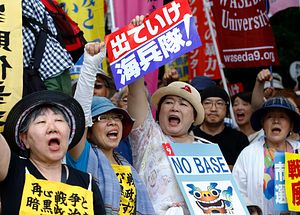On September 30, opposition lawmaker and first-time contender Denny Tamaki won the Okinawa gubernatorial election based on a strong anti-U.S. military agenda. He defeated Atsushi Sakima, the former mayor of the Okinawan city of Ginowan.
The charismatic radio personality turned politician won 55 percent of the vote against main rival Sakima, who had the backing of Japan’s ruling party, the Liberal Democratic Party (LDP). Mayors of Ginowan, which is home to the controversial U.S. Marine Corps Air Station Futenma, had previously boasted a six election winning streak in Okinawa’s gubernatorial races. However, with the relocation of the U.S. base taking center stage, Sakima’s strategy to withhold his attitude on the question cost him the election.
Okinawa, Japan’s southernmost island prefecture, is known as a tropical getaway positioned between Taiwan and mainland Japan – and as the major location for U.S. troops based in the country. Although it makes up just 0.6 percent of Japan’s national territory, Okinawa is home to half of Japan’s 54,000 American troops and 62 percent of the U.S. military bases in Japan. But in recent years, residents have reached a new level of frustration from countless military aircraft safety breaches and deadly malfunctions, while living with the bitter memory of the murder of a 20-year-old woman in 2016 and the gang rape of a 12-year-girl by U.S. servicemen in 1995.
After his momentous victory, Tamaki wasted no time reiterating his complete devotion to obstructing the relocation of the Futenma air base to the more sparsely populated northern Henoko district within Okinawa. The move, first negotiated in 1996, was the central government’s solution to growing local opposition toward having a U.S. air base in a densely populated neighborhood. Opponents of the relocation, however, want the base removed from Okinawan soil entirely, not just relocated within the prefecture. Accordingly, Tamaki urged the central government to arrange negotiations with Washington to move the Futenma military base completely off the island to other strategic locations such as Guam or Australia.
Just two weeks before the official governor race began, Tamaki stepped up to carry on the legacy of his predecessor, Governor Takeshi Onaga, a staunch opponent to the U.S. base who died suddenly in August from pancreatic cancer. For locals, Onaga’s death gave new life to the relocation issue, and opposition to Henoko gained momentum once again. Onaga’s wife publicly backed Tamaki over Sakima, effectively redirecting an influential alliance of anti-U.S. base factions toward Tamaki. That was key to his electoral success.
On Wednesday, Tamaki spoke with reporters outside his home. Declaring himself the political successor to Onaga, Tamaki pledged to uphold Onaga’s dying wish of putting an end to the construction of the new Henoko base. As the new governor, Tamaki made an impromptu first visit to the planned Henoko facility, which also inspired 150 anti-base protesters to gather at the gate of the U.S. military’s Camp Schwab, where soil was arriving to fill the land in preparation for relocation.
The Okinawan election was a historical defeat for the LDP, as it weakens Prime Minister Shinzo Abe’s goal of further strengthening the U.S.-Japan security pact. Abe said he will take the results of the election seriously and aims to meet with Tamaki as soon as his schedule permits to discuss Okinawa’s development and reducing the burden of the base on locals.
However, Chief Cabinet Secretary Yoshihide Suga, who flew to Okinawa to rally support for Sakima before the polls, said the election results would not sway the government’s attitude on relocating the U.S. air station to Henoko. On Tuesday, after Abe’s cabinet reshuffle, Japan’s new Defense Minister Takeshi Iwaya said he will continue to fight for the relocation of the U.S. military base even if it means finding a new site in Okinawa prefecture.
Tamaki rallied his supporters at the demonstration by calling on Japan and the U.S. government to start listening to democratic voices. He vowed to put all his energy into showing the world that democracy begins here.
As Japan’s central government continues to ignore local opposition, Tamaki is expected to push through an ordinance for a prefecture-wide referendum on the Henoko relocation that could be approved as early as spring 2019.
Tamaki’s proposal for a referendum comes from the frustrations felt by locals over the inability of central and local governments to reach a conclusion. Tamaki said even if the matter is fought in court, Onaga’s preferred strategy, no legal resolution will quash local animosity toward the U.S. presence on the island without dialogue.

































